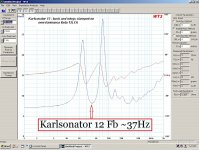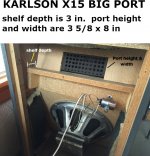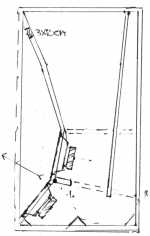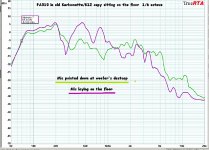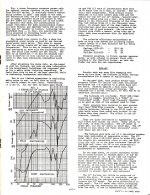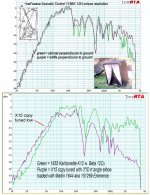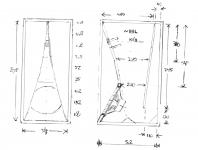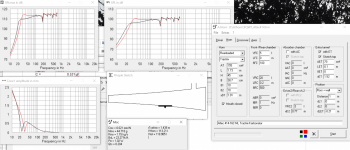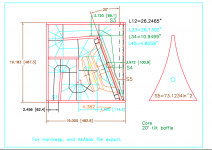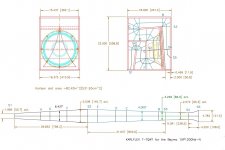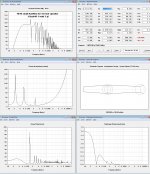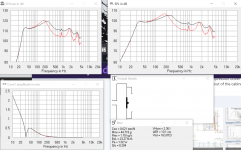will the tapered cylinder shape of the casing be random?I believe "The Imperial Assault Helmet" belongs to the Karlson family
https://longkft.hu/audioblog/a2o-a-birodalmi-rohamsisak/
Hello everyone. Long time viewer but approaching build time very soon, so I hope one of you experienced builders may have some guidance. I've got an Altec 414-16C coming this week, does anyone have some recommendations on a Karlson type enclosure as an alternative to a straight TQWT? I have seen a good sounding youtube video with one in a K12 by the looks of it, but otherwise haven't seen it in any of the Karlson/Karlsonator/xKi threads.
Typical T/S parameters for the 414: Vas=230L, Qts 0.25, Qms=7.4, Fs=32Hz, Sd = 511, Xmax=3.81mm
My brother used to run a Dutch Karlson K12, but I want to give the 414 space to breath, so a K15 or 1.35/1.2 (height/width depth) scaled up Karlsonator12 looks suitable. With that Karlsonator scaling the entire path length would be about 2.68m which would 1/4 wave of the Fs (which Freddy mentioned as the best sounding and this makes a lot of sense to me).
Efficiency is an important factor to me (I'll design/build a tube amp for it, but I'd rather stay with low watts). I'm not hung up about flat responses; the room modes will prop up the response around 18, 36 and 57Hz - so a gentle 6-10dB roll off to Fs is fine.
Typical T/S parameters for the 414: Vas=230L, Qts 0.25, Qms=7.4, Fs=32Hz, Sd = 511, Xmax=3.81mm
My brother used to run a Dutch Karlson K12, but I want to give the 414 space to breath, so a K15 or 1.35/1.2 (height/width depth) scaled up Karlsonator12 looks suitable. With that Karlsonator scaling the entire path length would be about 2.68m which would 1/4 wave of the Fs (which Freddy mentioned as the best sounding and this makes a lot of sense to me).
Efficiency is an important factor to me (I'll design/build a tube amp for it, but I'd rather stay with low watts). I'm not hung up about flat responses; the room modes will prop up the response around 18, 36 and 57Hz - so a gentle 6-10dB roll off to Fs is fine.
Good choice of driver! Do you know what MF/HF solution you'll be using above the Karlson?
My present line of thinking when doing a Karlson for a specific driver. This has not really been tested, but isn't too out-there and checks out OK in simulation.
a/ driver selection, in order of priority:
1/ Qts: 0.25 to 0.45
2/ Fs: the lower the Qts, the lower Fs should be
3/ Vas: high-compliance driver prefered
4/ rising response is prefered
b/ front chamber design:
1/ set internal height to ~2.5x driver nominal diameter
2/ set internal width to driver nominal diameter + 1-2"
3/ set max depth to ~0.5x nominal driver diameter (aperture panel to deepest internal baffle distance)
4/ set driver baffle angle between 15-25deg
5/ set driver baffle height to ~60% of internal height
c/ rear chamber design:
1/ calculate QB3 or max-flat BR alignment
2/ reduce Vb to 0.4-0.5x max-flat value
3/ raise Fb to 1.5-1.75x max-flat value
4/ new alignment should provide a ~3dB bass hump
5/ set rear chammber depth to desired Vb, accounting for height and width values and internal geometry calculated in "b/"
d/ venting scheme:
1/ distributed small holes on a grid on reflector panel
2/ Qts < 0.32 = 0.5" holes
3/ Qts 0.33-0.40 = 0.375" holes
4/ Qts > 0.40 = 0.25" holes
5/ drill holes until desired Fb is reached
6/ distribute the holes symmetrically in height and width as much as possible, drilling additional holes inwards
e/ K-slot design:
1/ slot start 0" to 3" from the top
2/ gap width 0.25" to 0.5"
3/ slot area 1.5-1.8x driver Sd
4/ slot width at driver intercept ~0.4x Dd
The Karlsonator 12 appears to be good according to the few builders, but I don't know its dimensions to say if it's a good match for a 414 and am too lazy to check.
As for giving the 414 'room to breathe', I prefer smaller back chambers to bump up the LF gain to match the front chamber's unavoidable upper-bass hump. This comes at the cost of extension naturally. Should be adapted to the room ideally. It will also help with efficiency in the pass-band. As far as not being hung up on a flat FR, that's good, because a Karlson will never give you that. I suggest prototyping a single cab with more affordable ply before committing a final build to quality and $$$ BB-ply or similar.
I suggest prototyping a single cab with more affordable ply before committing a final build to quality and $$$ BB-ply or similar.
My present line of thinking when doing a Karlson for a specific driver. This has not really been tested, but isn't too out-there and checks out OK in simulation.
a/ driver selection, in order of priority:
1/ Qts: 0.25 to 0.45
2/ Fs: the lower the Qts, the lower Fs should be
3/ Vas: high-compliance driver prefered
4/ rising response is prefered
b/ front chamber design:
1/ set internal height to ~2.5x driver nominal diameter
2/ set internal width to driver nominal diameter + 1-2"
3/ set max depth to ~0.5x nominal driver diameter (aperture panel to deepest internal baffle distance)
4/ set driver baffle angle between 15-25deg
5/ set driver baffle height to ~60% of internal height
c/ rear chamber design:
1/ calculate QB3 or max-flat BR alignment
2/ reduce Vb to 0.4-0.5x max-flat value
3/ raise Fb to 1.5-1.75x max-flat value
4/ new alignment should provide a ~3dB bass hump
5/ set rear chammber depth to desired Vb, accounting for height and width values and internal geometry calculated in "b/"
d/ venting scheme:
1/ distributed small holes on a grid on reflector panel
2/ Qts < 0.32 = 0.5" holes
3/ Qts 0.33-0.40 = 0.375" holes
4/ Qts > 0.40 = 0.25" holes
5/ drill holes until desired Fb is reached
6/ distribute the holes symmetrically in height and width as much as possible, drilling additional holes inwards
e/ K-slot design:
1/ slot start 0" to 3" from the top
2/ gap width 0.25" to 0.5"
3/ slot area 1.5-1.8x driver Sd
4/ slot width at driver intercept ~0.4x Dd
The Karlsonator 12 appears to be good according to the few builders, but I don't know its dimensions to say if it's a good match for a 414 and am too lazy to check.
As for giving the 414 'room to breathe', I prefer smaller back chambers to bump up the LF gain to match the front chamber's unavoidable upper-bass hump. This comes at the cost of extension naturally. Should be adapted to the room ideally. It will also help with efficiency in the pass-band. As far as not being hung up on a flat FR, that's good, because a Karlson will never give you that.
Thank you IG81 for sharing your approach and breaking it down so nicely; I will dive into this new 'homework' now! I'm nicely delighted to be gifted a recipe as opposed to a product 
I mentioned space to breath more as that I wanted to take size out of the <<size-extension-efficiency>> trade-off triplet in speaker design. The room is 9.6 x 6m (~32x20ft). I will go with your suggestion of a single experimental cabinet, maybe even a frame & skin approach so I can change things.
The HF part will be the EV DH1A - most likely 'hornless' pointing up as an omnidirectional driver but I will experiment with the throat to see what can be done with it (K-tube, expanding k-tube). At present this approach seems to fill the space very naturally. I've only had it for a week but this driver is a revelation to me how much nuance, detail, energy and dynamics comes from it, even at very low listening levels.
I mentioned space to breath more as that I wanted to take size out of the <<size-extension-efficiency>> trade-off triplet in speaker design. The room is 9.6 x 6m (~32x20ft). I will go with your suggestion of a single experimental cabinet, maybe even a frame & skin approach so I can change things.
The HF part will be the EV DH1A - most likely 'hornless' pointing up as an omnidirectional driver but I will experiment with the throat to see what can be done with it (K-tube, expanding k-tube). At present this approach seems to fill the space very naturally. I've only had it for a week but this driver is a revelation to me how much nuance, detail, energy and dynamics comes from it, even at very low listening levels.
Predicting the behavior of the front chamber and its response is probably a bit harder and best measured, then the tuning of the rear chamber can be adjusted to tilt the response to your needs. If you get a tamer upper-bass peak than some other Karlson/driver combos, you will be able to trade-off midbass sensitivity for extension by tuning lower and/or building a larger back chamber.
IG81's "recipe" looks sound and quite comprehensive Distributive hole or slit vents produce high velocities (and overtones) when driven with sine-wave at Fb. I'm not sure if this is a concern with music. (which usually does not "stand still")
It would be interesting (not for your build) to try a large front chamber - Carl Neuser spoke of 1.1 cubic foot rear - 1.9 cubic feet front with ~120Hz tuning to try for a 10" (Eminence B102 current version). I know that has been done for bass guitar but wonder if feasible sonically for hifi -? 1.9 cubic foot is sufficient for some 15" K-type.
I've not used that Altec but assume it will have a very sweet midrange and clean bass.
With my small K18 and a particular set of tapers, better sound was produced with a big gap (~1.2") at the top. 5/8" in that case sounded congested - I was using an 18 so take that into account.
.
It would be interesting (not for your build) to try a large front chamber - Carl Neuser spoke of 1.1 cubic foot rear - 1.9 cubic feet front with ~120Hz tuning to try for a 10" (Eminence B102 current version). I know that has been done for bass guitar but wonder if feasible sonically for hifi -? 1.9 cubic foot is sufficient for some 15" K-type.
I've not used that Altec but assume it will have a very sweet midrange and clean bass.
With my small K18 and a particular set of tapers, better sound was produced with a big gap (~1.2") at the top. 5/8" in that case sounded congested - I was using an 18 so take that into account.
.
Last edited:
Most interesting - thank you; it's starting to make sense how it hangs together. I tried the QB3 flat response and it got me a shocking 32 litre with a tuning frequency of 56Hz before even applying the 'Karlson' factors on Vb and Fs. I can see how higher tuning frequencies with smaller volume lift a wider spectrum than lower tuned ones.
@freddi this one is a 414 (12" instead of 15/16"..) but it has a rather low Fs and Qts.
@freddi this one is a 414 (12" instead of 15/16"..) but it has a rather low Fs and Qts.
Carl gave the following as a rough guideline
A formula for rear chamber volume -
Rear chamber: vbr ~(vas*qts*fs)/fc (CN used fc="50")
(230*0.25*32)/50 = 36.8l (pretty close to Karlson's K12)
Front chamber: vbf ~0.5 vbr;
Lowpass rear shelf gap area: slp ~0.2-0.4 sd
Mr B1 - what were your impressions of your brother's "Dutch" K12 with regards to midrange, bass punch, strengths and weaknesses ? (If
I ever get back home then could convert a Karlsonette to similar with a new vent panel)
A formula for rear chamber volume -
Rear chamber: vbr ~(vas*qts*fs)/fc (CN used fc="50")
(230*0.25*32)/50 = 36.8l (pretty close to Karlson's K12)
Front chamber: vbf ~0.5 vbr;
Lowpass rear shelf gap area: slp ~0.2-0.4 sd
Mr B1 - what were your impressions of your brother's "Dutch" K12 with regards to midrange, bass punch, strengths and weaknesses ? (If
I ever get back home then could convert a Karlsonette to similar with a new vent panel)
That is a very straight forward guide - thank you, freddi.
As for my brother's Dutch K12 (we lived in the Netherlands then, so it probably was!). This had the 3 slits and a Vifa soft dome tweeter in one of the wings to take over from what I think was an Alnico Philips wideband unit. It was divided with a straight Butterworth 12dB crossover around 3000Hz if I remember correctly. The entire rear opened which made it easy to service.
Now, this is a long time ago and before I really started paying attention to sound quality, but a couple of things stood out:
As for my brother's Dutch K12 (we lived in the Netherlands then, so it probably was!). This had the 3 slits and a Vifa soft dome tweeter in one of the wings to take over from what I think was an Alnico Philips wideband unit. It was divided with a straight Butterworth 12dB crossover around 3000Hz if I remember correctly. The entire rear opened which made it easy to service.
Now, this is a long time ago and before I really started paying attention to sound quality, but a couple of things stood out:
- It sounded better than most people's speakers and we thought it looked much better too; this unit was a low-gloss white all around.
- It was a very low-fatigue listen, also at higher volumes
- It sounded effortless all the way up to near break up
- It had a very controlled, well defined bass; much like closed speakers, but it extended lower and didn't sound damped nor boxy
- Subjectively it had a more bass extension than it actually did - as in maybe overtones suggesting lower frequencies. This worked for music, not sine waves.
- We noticed an effect that at very low listening levels, close up it had very impressive bass extension but this went at normal listening levels. We were not entirely sure what this was but it stood out with the Karlsons.
Regarding the distributed venting I suggested in d/ - I think it can help in removing a null caused by a single vent location and thus a deper and narrower cancellation bandwidth. There is also a resistive element added, which I suppose is better on higher Qt drivers as obliquely implied by my hole size recommendation. I have not tested distortion on sine waves on my single such build, but would assume it would not be of much concern with music.
Effect of distributed venting versus single vent on impedance (other than an added Zobel on the red trace):

Effect on response:

When doing your rear chamber design, don't forget to include any drive impedance from the tube amp you intend on using, on top of the typically assumed cable, connector and crossover component resistance.
It`s not surprising you end-up with a small volume with Qts = 0.25, that's a mighty powerful motor. Good that Fs is low though. I whish I`d had this driver when I had my K12, though the Celestion TF1020 did quite well.
Effect of distributed venting versus single vent on impedance (other than an added Zobel on the red trace):
Effect on response:
When doing your rear chamber design, don't forget to include any drive impedance from the tube amp you intend on using, on top of the typically assumed cable, connector and crossover component resistance.
It`s not surprising you end-up with a small volume with Qts = 0.25, that's a mighty powerful motor. Good that Fs is low though. I whish I`d had this driver when I had my K12, though the Celestion TF1020 did quite well.
FWIW I think GregB's stock Karlsonator 12 would work pretty well with this Altec - but it would be fun to try something else K-ish.
At 37Hz Fb Karlsonator12 is tuned a bit more than a half octave lower than Karlson's little "12".
A provision in a test box could be make for a reflector panel to hold the big EV compression driver - it would have to have a K-tube in that mode, otherwise the treble would be buried in echoes from the upper front chamber.
It would be good in a test K to have the port panel removable as to be able to switch between port schemes and port tuning. Recollections of Ann Karlson's X15 organ speaker said it was tuned with 43 - 3/8" holes. I think we have proof of that being done sometimes with the pictures of a large-port X15 having a board insert with about that many holes drilled. There have been other X15 with the big port open and I think that led to the flurry of X15 size K-couples appearing in the early 80's by a number of companies.
A question to IG81 - how much of a given K's front chamber is "active" ? Seems to me that a certain proportion of the thinning wedge (whose aperture is widening to full cabinet width) does not contribute much is any to the front chamber "volume"
@Mr B1 - thanks for the recollections of the "Dutch K12". It's author appeared to be familiar with Karlson's 1956 distributed slit vent K12 (published July 1958). It's interesting as the slots have 15mm height and very little drag compared to saw blade height slits - that implies the front chamber's aperture, narrow at the top, is doing a lot to set system resonance.
At 37Hz Fb Karlsonator12 is tuned a bit more than a half octave lower than Karlson's little "12".
A provision in a test box could be make for a reflector panel to hold the big EV compression driver - it would have to have a K-tube in that mode, otherwise the treble would be buried in echoes from the upper front chamber.
It would be good in a test K to have the port panel removable as to be able to switch between port schemes and port tuning. Recollections of Ann Karlson's X15 organ speaker said it was tuned with 43 - 3/8" holes. I think we have proof of that being done sometimes with the pictures of a large-port X15 having a board insert with about that many holes drilled. There have been other X15 with the big port open and I think that led to the flurry of X15 size K-couples appearing in the early 80's by a number of companies.
A question to IG81 - how much of a given K's front chamber is "active" ? Seems to me that a certain proportion of the thinning wedge (whose aperture is widening to full cabinet width) does not contribute much is any to the front chamber "volume"
@Mr B1 - thanks for the recollections of the "Dutch K12". It's author appeared to be familiar with Karlson's 1956 distributed slit vent K12 (published July 1958). It's interesting as the slots have 15mm height and very little drag compared to saw blade height slits - that implies the front chamber's aperture, narrow at the top, is doing a lot to set system resonance.
Attachments
@freddi Since you talked about something K-ish...I was toying with different horn shapes to fit the Karlson general design. So here's something 'out there' attached: it's a more instrument shaped front chamber kind of in-line with the sketches of Karlson patents without parallel surfaces. The 2 driver thing can be ignored. It's a tractrix horn so which allows the woofer to be placed after the fold. The tqwt itself sims well. The port could be slits or a pipe sticking into the horn, and it could be positioned at a null point like 1/17 or 1/11 of the total length.
You made a statement about Karlsonators sounding good when the overall path length is 1/4 of the Fs wavelength. Would this be because at max speed crossing the null the compressed airwave will reach the other side of the woofer when it's at maximum extension - as a reason why cone motion is so well controlled, apart from the front and back loading?
You made a statement about Karlsonators sounding good when the overall path length is 1/4 of the Fs wavelength. Would this be because at max speed crossing the null the compressed airwave will reach the other side of the woofer when it's at maximum extension - as a reason why cone motion is so well controlled, apart from the front and back loading?
Attachments
A question to IG81 - how much of a given K's front chamber is "active" ? Seems to me that a certain proportion of the thinning wedge (whose aperture is widening to full cabinet width) does not contribute much is any to the front chamber "volume"
Hard to answer, but I agree that the lower part of the front chamber becomes 'useless' at some point. A bit like a K-tube; the flare likely does not matter too much (loading-wise) once it's more than halfway open. I don't remember whose and what build they are, but there are some pictures out there of Karlsons with mostly unloaded drivers, as far as the front chamber goes at least. It can be used to adjust the TH/BP behavior to a certain extent I suppose.
@Mr B1
assuming your 414 specs are ballpark, what is the internal volume of the TQWT portion of your proposed K-coupler and what overall dimensions would the K-hybrid have ?
Although in uncharted territory, it looks like it could be a winner.
Did you simulate the rear with hornresp? - what effects would the front chamber have upon the TQWT'response?
There ought to be a way to estimate with hornresp. My little Kube12 is squat aspect so series bandpass sims don't seem far off.
I've heard cases of K-coupler where the overall sound including midrange is "improved" vs a direct radiator - particularly with 18" drivers - of course it can go the other way -a slit vent K12 loaded with Dayton 12" PA-310 sounds like its 20 feet under water while a Kappa 12A only a few dB loud in the mids is pretty good - and very striking on synth-organ. I'd love to have a Dutch K12 for reference.
Vent location seems to have a lot of impact with K and can get really ugly with regards to dips. Perhaps IG81 will weigh in on this matter.
assuming your 414 specs are ballpark, what is the internal volume of the TQWT portion of your proposed K-coupler and what overall dimensions would the K-hybrid have ?
Although in uncharted territory, it looks like it could be a winner.
Did you simulate the rear with hornresp? - what effects would the front chamber have upon the TQWT'response?
There ought to be a way to estimate with hornresp. My little Kube12 is squat aspect so series bandpass sims don't seem far off.
I've heard cases of K-coupler where the overall sound including midrange is "improved" vs a direct radiator - particularly with 18" drivers - of course it can go the other way -a slit vent K12 loaded with Dayton 12" PA-310 sounds like its 20 feet under water while a Kappa 12A only a few dB loud in the mids is pretty good - and very striking on synth-organ. I'd love to have a Dutch K12 for reference.
Vent location seems to have a lot of impact with K and can get really ugly with regards to dips. Perhaps IG81 will weigh in on this matter.
Attachments
Last edited:
look at these graphs - the Acoustic Control 115BK is pretty much the same size as Karlson's X15. The X15 in this case was tuned low for a particular Emimemce-Martin Sound 15. Both graphs are 1/24th octave smoothed and approximate ground plane with the mic laying on the ground *. (*possibly the floor with X15 and Karlsonette) There was no damping material whatsoever in 115BK
Attachments
@freddi I've redone the concept sketch based on the 414 now, using the parameters from here http://alteclansingunofficial.nlenet.net/Thiele-Small.html (I should have 414s in my hands soon). I used AjHorn for the calculation; I haven't worked with hornresp yet or attempted to model the front chamber - so there's quite a few blindspots, including me being green at this. Ajhorn doesn't sim the floor coupling effect which Karlsons enjoy, so I'm presuming I can get away with a lower tuned cabinet (-6db bass shelf).
The result here is a 170L enclosure with about 120L : 40L ratio and about 10L lost through internal 'scaffolding'. I've ran 2 different tunings through it: one with a 35cm2 port (black) and one with a 70cm2 port (red). The port is 10cm / 4" deep and is position to sit on the 11th harmonic of the horn length (1m73 / 5ft8). As with your graphs the tuning, position of drivers and ports make quite a difference.
As for predicting the front-TQWT interaction, I think the Karlsonator is our best guide - despite it being less aperiodic than this concept.
My direction currently is to do a 143L Hiraga-style downfiring MLTL and a form of Karlson to see which one deserves a proper build
I'll ask my brother is he still has his K12
The result here is a 170L enclosure with about 120L : 40L ratio and about 10L lost through internal 'scaffolding'. I've ran 2 different tunings through it: one with a 35cm2 port (black) and one with a 70cm2 port (red). The port is 10cm / 4" deep and is position to sit on the 11th harmonic of the horn length (1m73 / 5ft8). As with your graphs the tuning, position of drivers and ports make quite a difference.
As for predicting the front-TQWT interaction, I think the Karlsonator is our best guide - despite it being less aperiodic than this concept.
My direction currently is to do a 143L Hiraga-style downfiring MLTL and a form of Karlson to see which one deserves a proper build
I'll ask my brother is he still has his K12
Attachments
Hi Mr B1
that has a very pleasing front aspect ratio and is very close in bulk to K15. I think it will go a half octave or better lower than using 414 in K15.
Perhaps you can try TB46 Karlflex model (Oliver Frazer)
It looks like it should have a very good sound on vocals and instruments including reaching lower organ pedals.
Have you picked a spot to internally mount your EV compression driver and K-tube? - That K-tube's tip can reach into the main slot plane - or if desired , extend a bit past the aperture - or could extend further out of the cabinet. Having the K-tube like Karlson did with X15 had a good sound to my way of thinking.
that has a very pleasing front aspect ratio and is very close in bulk to K15. I think it will go a half octave or better lower than using 414 in K15.
Perhaps you can try TB46 Karlflex model (Oliver Frazer)
It looks like it should have a very good sound on vocals and instruments including reaching lower organ pedals.
Have you picked a spot to internally mount your EV compression driver and K-tube? - That K-tube's tip can reach into the main slot plane - or if desired , extend a bit past the aperture - or could extend further out of the cabinet. Having the K-tube like Karlson did with X15 had a good sound to my way of thinking.
Attachments
@IG81 Thank you for the feedback. Yes AJHorn does support TH and BP6 - just not in combination with a another form. I've set it up as a bandpass enclosure with an identical tuned rear chamber. As you predicted with that there's a hump around 200hz. I ran a variant with 20L and 40L (red) front chamber to maybe reflect the k-coupler tilted baffle / opening. The 200Hz hump could work out well in-room.
@freddi I'll be going with placing the EV on top as an up-firing omni directional driver - at least at first. I will try k-tubes if I feel the need to direct the sound. My idea is to have room filling 'live' sound, imaging is secondary. I found the Karlflex thread - thank you; those plans look like a very nice way to construct a sub! Probably not for this project but I'll remember it. Did you ever hear it play?
@freddi I'll be going with placing the EV on top as an up-firing omni directional driver - at least at first. I will try k-tubes if I feel the need to direct the sound. My idea is to have room filling 'live' sound, imaging is secondary. I found the Karlflex thread - thank you; those plans look like a very nice way to construct a sub! Probably not for this project but I'll remember it. Did you ever hear it play?
Attachments
- Home
- Loudspeakers
- Full Range
- Karlson
